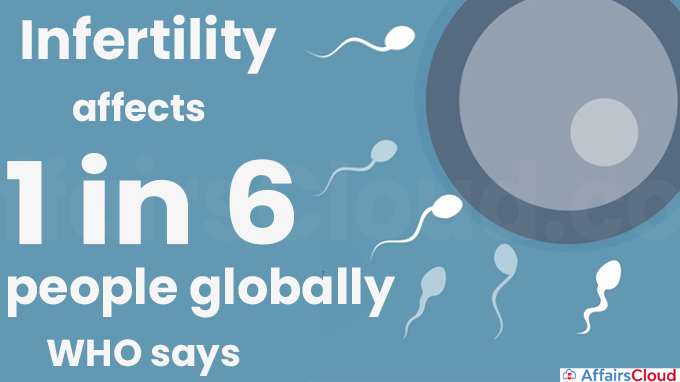 According to the World Health Organization (WHO) report, ‘Infertility prevalence estimates 1990-2021’ released on April 03, 2023, Around 17.5% of the adult population (roughly 1 in 6 ) worldwide experience infertility in their lifetime.
According to the World Health Organization (WHO) report, ‘Infertility prevalence estimates 1990-2021’ released on April 03, 2023, Around 17.5% of the adult population (roughly 1 in 6 ) worldwide experience infertility in their lifetime.
- The report, the first of its kind in a decade, provides estimates of the global and regional prevalence of infertility by analyzing all relevant studies from 1990 to 2021
- As per the report, the Overall pooled Lifetime prevalence of infertility is estimated to be 17.5% and the Period prevalence of infertility is estimated to be 12.6%.
What is Infertility?
As per WHO, Infertility is a disease of the male or female reproductive system defined by the failure to achieve a pregnancy after 12 months or more of regular unprotected sexual intercourse.
WHO stated the need to address infertility as it is central to achieving Sustainable Development Goal (SDG) 3 – Ensure healthy lives and promote well-being for all at all ages – and SDG 5 – Achieve gender equality and empower all women and girls.
Key Findings of the Report:
Global infertility prevalence estimates:
The 2022 global infertility prevalence estimates (Based on data from 1990 to 2021) are:
i.Regardless of where they live and what resources they have, globally, an estimated 1 out of every 6 people are affected by the inability to have a child at some point in their life.
ii.Lifetime prevalence is defined as the proportion of a population who have ever experienced infertility in their life. The lifetime prevalence of infertility is estimated to be 17.5%.
iii.Period prevalence is defined as the proportion of a population with infertility at a given point or interval in time, which may be current or in the past. The period prevalence of infertility is estimated to be 12.6%.
Region wise infertility prevalence estimates:
i.The Western Pacific Region had the highest prevalence of lifetime infertility (23.2%), followed by the Region of the Americas (20.0%) and the European Region (16.5%).
ii.Period infertility was highest in the African Region (16.4%), followed by the Western Pacific Region (13.0%) and the European Region (12.4%).
iii.The Eastern Mediterranean Region had the lowest lifetime and period infertility, at 10.7% and 10.0%, respectively.
iv.Estimates of infertility prevalence are similar across countries regardless of country income level.
- Lifetime prevalence was 17.8% in high-income countries and 16.5% in low- and middle-income countries.
- Period infertility prevalence was 12.6% for high-income countries and 12.6% for low- and middle-income countries.
Note – The report stated that no studies from the South-East Asia Region provided 12-month infertility prevalence data.
The data in the report also emphasize the need to provide access to prevention, diagnosis and treatment of infertility.
Disaggregating primary and secondary infertility:
i.Infertility is classified into primary or secondary in which Primary infertility is when a pregnancy has never been achieved by a person, and secondary infertility is when at least one prior pregnancy has been achieved.
ii.For primary infertility, pooled lifetime and period prevalences were 9.6% and 9.0% respectively. For secondary infertility, pooled lifetime and period prevalences were 6.5% and 4.9% respectively.
As per the report, the treatment of infertility, including assisted reproductive technology such as in vitro fertilization (IVF) is underfunded and inaccessible to many due to high costs and limited availability.
The report highlights the need to increase access to affordable, high-quality fertility care for those in need.
Recent Related News:
The World Health Organization (WHO) Global Report On Sodium Intake Reduction states that nations must make “massive efforts” to get people to consume less salt, which can lower their risk of developing cancer, heart disease, and stroke.
About World Health Organization (WHO):
Director General – Dr Tedros Adhanom Ghebreyesus
Headquarters -Geneva, Switzerland
Establishment – 7 April 1948




